Outbreak of China’s Wuhan coronavirus continued to be a big market mover last week. According to China’s own numbers, new cases in the country seemed to have slowed even though new daily deaths maintained at around 100 level. What’s worrying is that contagion to other countries, in particular Asia, is getting alarmingly serious. In particular, number of infections in South Korea skyrocketed to 433 as of Saturday. Excluding Diamond Princess liner, cases in Japan also reached 100 while Singapore at 86 is not far behind. Five deaths are record in Iran, making it the largest outside of China. The coronavirus has now spread to over 30 countries including Taiwan.
Global financial markets turned into risk-off mode, in particular towards the end of the week, with heavy safe haven flows into Gold and US treasuries. Yen ended as the weakest one as the coronavirus contagion creates economic and political uncertainties Japan. Even the 2022 Summer Olympic could now be in jeopardy. Australian dollar followed as next weakest as rebound in unemployment rate added to the case of April RBA easing. Swiss Franc was the strongest one on risk aversion, followed by Canadian Dollar. Dollar was originally one of the strongest, but ended mixed, partly due to profit taking, falling yields, and speculations of Fed cut.
Dollar index resumed long term up trend, then halted
Dollar index originally surged last week to as high as 99.91, resuming long term up trend from 88.26 (2018 low). However, the index pared back much of recent gains on towards the end, after markets increased bet on a Fed rate cut this year (60% chance by June meeting). There seems to be some concern on the impact to the US economy, from the outbreak of China’s coronavirus, which is spreading to Asia. Safe haven flows turned more into gold instead, while free fall in yields also weighed.
Considering the depth of the retreat, 99.91 should be a short term top in DXY. Near term outlook is turned neutral for consolidation, with risk of deep correction. But downside is expected to be contained by 38.2% retracement of 96.35 to 99.91 at 98.55 to bring rebound. Current up trend is still expected to resume sooner or later to 78.6% retracement of 103.82 to 88.26 at 100.49 next.
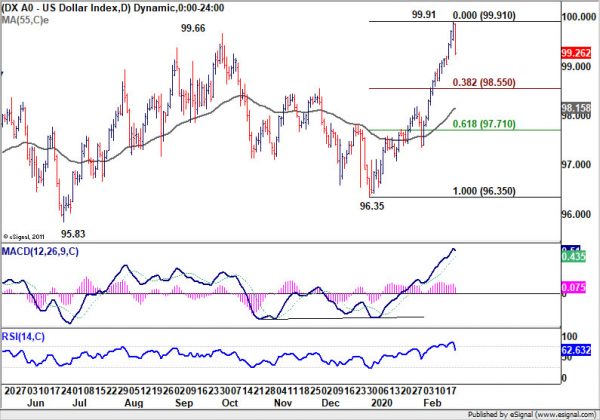
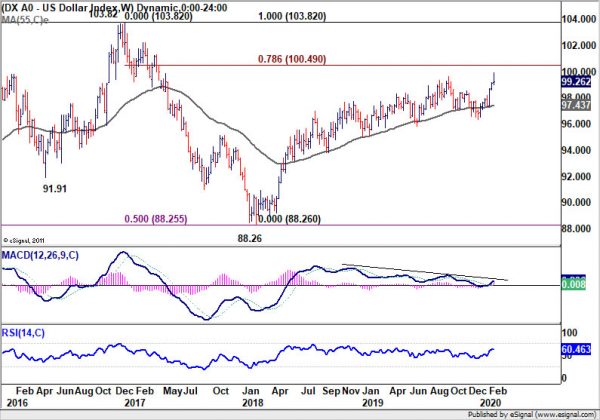
10-year yield could break 1.429 support to 2016 low at 1.336
US treasury yields were dragged down by risk aversion, with 30-year yield hitting new record low at 1.886, before closing at 1.1918. The picture in 10-year yield is no too far from it. TNX hit as low as 1.439, just above 1.429 low, before closing at 1.471. Near term outlook stays bearish as long as 1.639 resistance holds. Current downside acceleration raises the chance of a break of 1.429. In that case, 2016 low at 1.336 would be the next target. It’s too early to tell, but if TNX is resuming multi-decade down trend, then 61.8% projection of 3.248 to 1.429 from 1.949 at 0.8248 would be the next long term target.
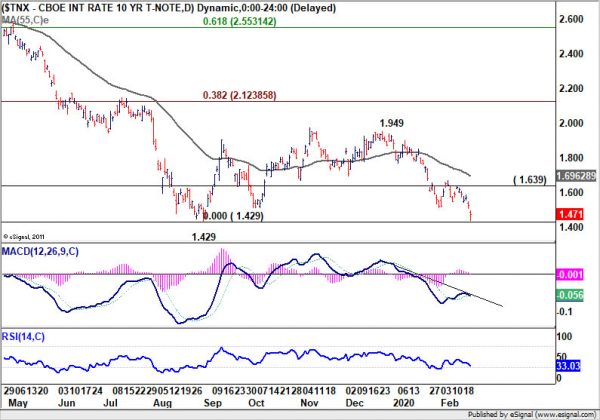
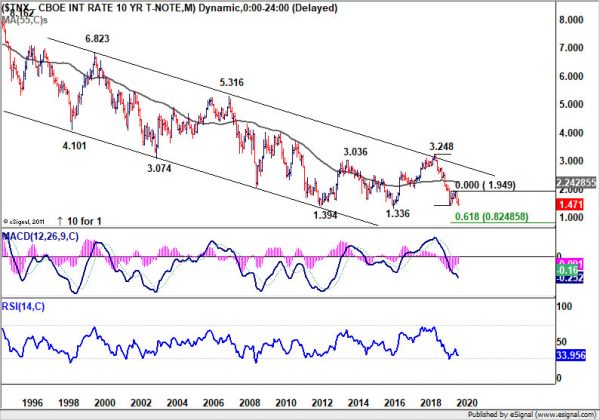
Gold extended up trend, heading to 1920.70 high?
Gold’s upside momentum was totally out of our expectations last week as it surged pass 1611.37 resistance without much hesitation. Strong upside acceleration seen towards the end of the week. With 61.8% projection of 1445.59 to 1611.37 at 1547.49 at 1649.94 in proximity, Gold might suffer a brief set back initially this week. But near term outlook will remain bullish as long as 1611.37 resistance turned support holds. Firm break of 1649.94 will pave the way to 100% projection at 1713.27. In the long term picture, with current upside acceleration as seen in monthly MACD, a retest on 1920.70 (2011 high) is a realistic scenario.
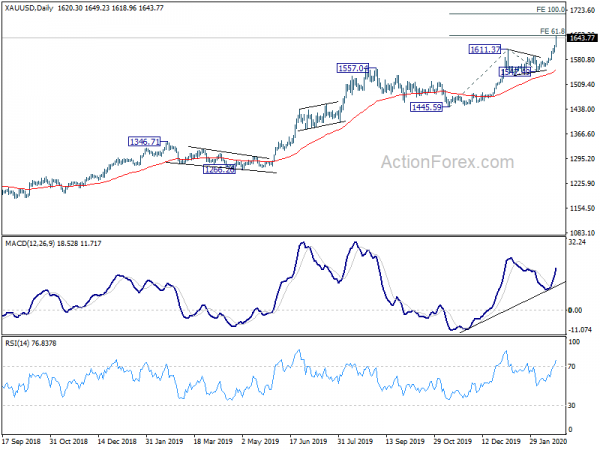
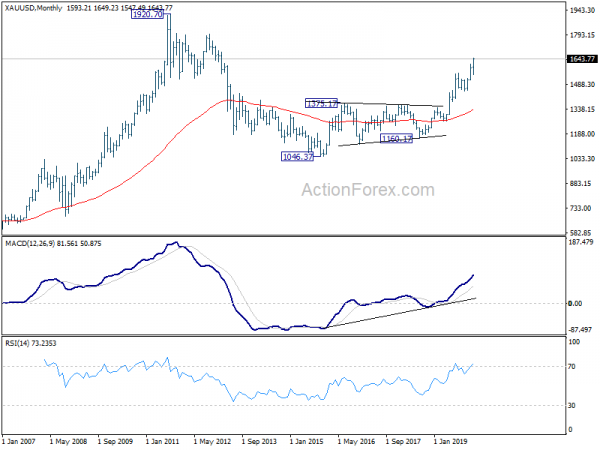
CHF/JPY ended as top mover as Yen hit hard by coronavirus
Fortune of Swiss Franc and Yen diverged totally in a relatively unusual situation. Yen suffered deep selling pressure due to contagion of coronavirus outbreak. While the majority of the 751 confirmed cases were mainly found in Diamond Princess liner, local cases of 100 and 3 deaths are already alarming.
BoJ Governor Haruhiko Kuroda already warned of the impact on exports, production, and tourism. Organizers for the Tokyo 2020 summer Olympics even postponed volunteer training that was scheduled to begin on Saturday. Prime Minister Shinzo Abe is under political pressure on his handling of the outbreak, in addition to the impact of last year’s sales tax hike.
CHF/JPY ended last week as the biggest mover, up more than 2%. With strong support seen from 55 day EMA, rise form 106.73 should be in progress, and it’s probably ready to resume. Initial focus in on 114.38 resistance this week. Firm break there will target 61.8% projection of 108.81 to 114.38 from 111.62 at 115.06. That will be the real test for the cross in near term. Decisive break there will confirm underlying bullishness (or weakness in Yen itself) and pave the way to 100% projection at 117.19.
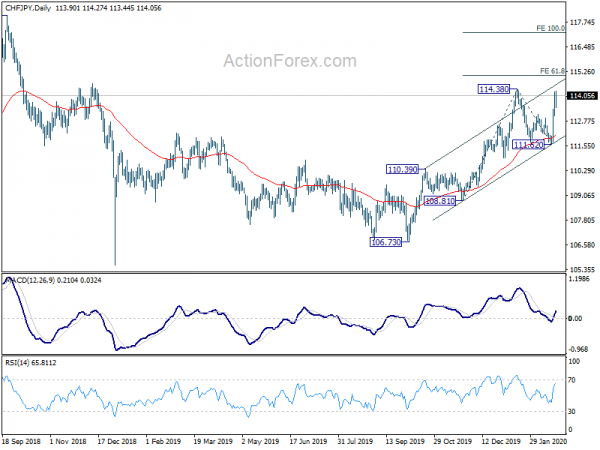
AUD/USD dropped to as low as 0.6586 last week as larger down trend finally resumed. As a temporary low was formed, initial bias is turned neutral this week for some consolidations first. But upside of recovery should be limited well below 0.6750 resistance to bring fall resumption. Break of 0.6586 will extend recent decline.
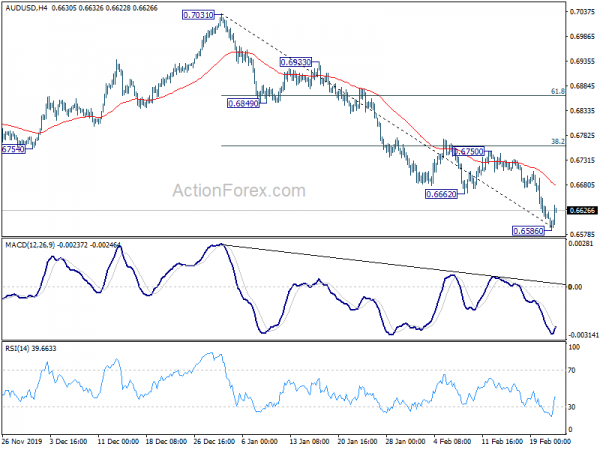
In the bigger picture, AUD/USD’s decline from 0.8135 (2018 high) is still in progress. It’s part of the larger down trend from 1.1079 (2011 high). Rejection by 55 week EMA affirms medium term bearishness. Next target is 0.6008 (2008 low). Outlook will stay bearish as long as 0.7031 resistance holds, even in case of strong rebound.
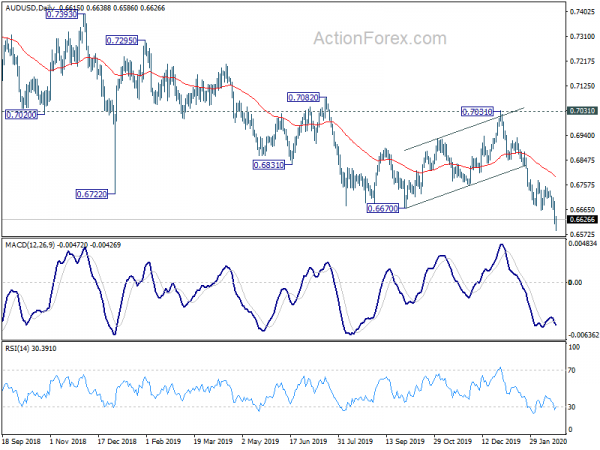
In the longer term picture, prior rejection by 55 month EMA maintained long term bearishness in AUD/USD. That is, down trend from 1.1079 (2011 high) is still in progress. Next downside target is 61.8% projection of 1.1079 to 0.6826 from 0.8135 at 0.5507.
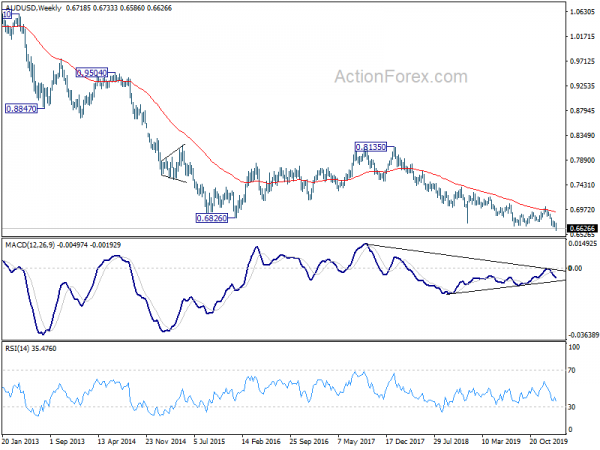
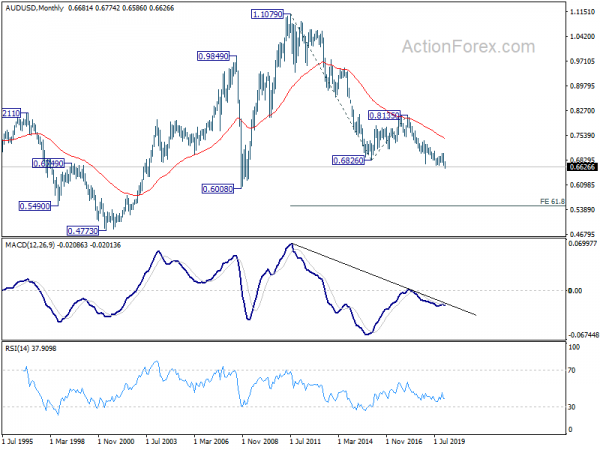

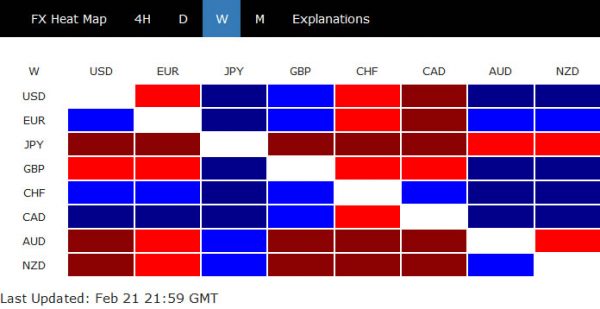
 Signal2forex.com - Best Forex robots and signals
Signal2forex.com - Best Forex robots and signals




